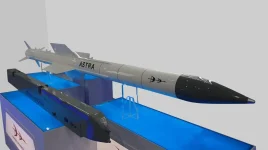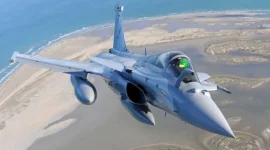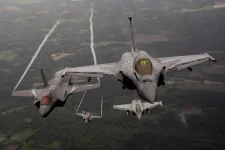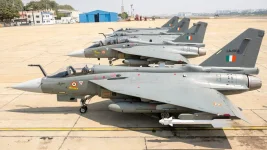- Views: 2K
- Replies: 8
The Indian Air Force (IAF) has intensified its efforts to develop a specialized electronic warfare (EW) aircraft designed to disrupt hostile electronic countermeasures and protect valuable strike formations.
According to defence sources, this renewed initiative follows the shelving of previous proposals to modify Sukhoi-30MKI fighters into a "Desi Growler"—an indigenous equivalent to the U.S. Navy's EA-18G—which faced significant financial and logistical challenges.
Currently, the IAF and the Defence Research and Development Organisation (DRDO) are engaged in high-level discussions to integrate established EW technologies onto existing airframes.
The Su-30MKI and the upcoming Tejas Mk2 have been identified as the primary contenders to fulfill the critical roles of standoff jamming and the suppression of enemy air defences (SEAD).
This strategic shift aims to close a critical capability gap in contested environments. Military planners are increasingly concerned that advanced integrated air defence systems (IADS) operated by adversaries, such as China, could effectively neutralize precision strikes.
By equipping aircraft with indigenous jammers, radar warning receivers, and anti-radiation missiles, the IAF intends to ensure safer entry corridors for its bomber squadrons. These requirements mirror lessons learned from recent tactical simulations conducted near the Line of Actual Control (LAC).
In the mid-2010s, a collaborative proposal by the IAF, DRDO, and Hindustan Aeronautics Limited (HAL) sought to convert a squadron of Su-30MKIs into a dedicated EW variant.
This "Desi Growler" concept envisaged a fleet of 10 to 20 aircraft armed with derivatives of the ground-based Samyukta EW system, Rudram anti-radiation missiles, and advanced digital radio frequency memory (DRFM) jammers.
The goal was to create a potent force multiplier capable of countering emerging threats, such as China’s J-15D electronic warfare jet, which was publicly unveiled in 2024.
However, the project lost momentum due to competing fiscal demands, particularly the ₹63,000 crore "Super Sukhoi" upgrade program, and budget constraints following the COVID-19 pandemic.
Sources confirmed that while the "Desi Growler" was a strong proposal, it was ultimately set aside after exploratory studies revealed complex integration issues with the aircraft's AL-31FP engines and the requirement for extensive structural modifications.
By 2025, the focus had shifted toward fleet-wide avionics upgrades under the Super Sukhoi program. While this initiative includes updated radar warning receivers and baseline EW suites, experts note that it does not provide the dedicated standoff jamming capabilities required for high-threat environments.
Undeterred by past setbacks, the IAF and DRDO have restarted development talks, leveraging mature technologies from platforms like the Netra Airborne Early Warning and Control (AEW&C) system and the Akashteer air defence network.
Sources indicate that while the specific technologies—such as the Unified Electronic Warfare Suite (UEWS) and AI-driven spectrum management—are ready, the final decision on the carrier platform is still being finalized.
Discussions held since mid-2025 have centered on a modular "pod-and-play" architecture. This approach would allow aircraft to be rapidly reconfigured for various mission profiles, from offensive counter-air operations to creating defensive electronic bubbles.
Initial prototypes are expected to incorporate DRDO’s High-Power Jammer (HPJ) technology, which reportedly demonstrated the ability to disrupt enemy radars at ranges exceeding 300 km during trials in 2024.
The project is deeply integrated with the Atmanirbhar Bharat roadmap, targeting 70-80% indigenous content to insulate the program from global supply chain disruptions.
The selection process has narrowed to the Su-30MKI and Tejas Mk2, citing their payload capacity and integration readiness.
The Su-30MKI, which forms the backbone of the IAF with over 260 units, offers numerous hardpoints suitable for heavy EW pods and conformal antennas. It is viewed as an ideal escort jammer for large-scale strike packages.
Furthermore, the "Super Sukhoi" Phase II upgrade could see these aircraft equipped with the indigenous Virupaksha GaN AESA radar, significantly enhancing their passive detection capabilities.
Conversely, the Tejas Mk2 offers the advantages of agility and a reduced radar cross-section (RCS).
Scheduled for its first flight in late 2026, this 4.5-generation medium fighter will feature the "Swayam Raksha Kavach" (Self-Protection Shield) suite. This system includes an Advanced Self-Protection Jammer (ASPJ) pod capable of generating "functional stealth" through electronic deception.
Insiders suggest that the Tejas Mk2 could serve as a nimble, forward-deployed EW node, working in tandem with heavier platforms like the Su-30MKI to provide comprehensive coverage.
This accelerated push for a dedicated EW asset is a direct response to regional security dynamics. The proliferation of advanced electronic countermeasures—exemplified by Pakistan’s upgraded Erieye AWACS and China’s Y-9G standoff jammers—poses a credible threat to the IAF's deep-strike capabilities.
A specialized EW aircraft would not only safeguard assets like the BrahMos-equipped Su-30s but also facilitate the creation of "kill webs" that link drones, fighters, and hypersonic missiles, a key pillar of the IAF’s capability roadmap for 2025-2047.




